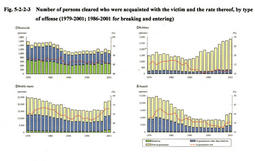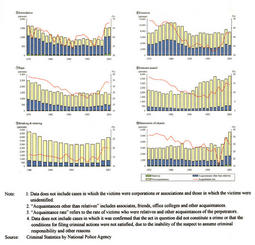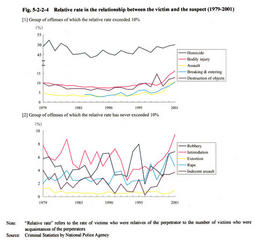| Previous Next Index Image Index Year Selection | |
|
|
2 Rate of acquaintance with victim Fig. 5-2-2-3 shows the number of persons cleared who were acquainted with the victim and the rate thereof (acquaintance rate), by type of acquaintance and type of offense.
In this subsection, "relatives" include the perpetrator's parents, children, siblings, spouse, or other relatives, irrespective of whether they live with the perpetrator. Parents and children include not only those with blood relationship but also stepparents, parents-in-law, stepchildren and children-in-law. A person who is in common-law marriage with the perpetrator is also considered to be the perpetrator's spouse. (1) Acquaintance rate The acquaintance rate for homicide has remained at a high level between 85% and 90%, without any significant change every year. This indicates that homicide is generally committed with a relatively clear and personal motive that is directed to individual victims such as grudge, and indiscriminant homicide and random killings are exceptional cases.
By type of offense, the acquaintance rate was high for intimidation, bodily injury, extortion, and assault, The rate was low for indecent assault, robbery and breaking and entering. The number of reported cases took an upward turn in 1996 in respect of many of the 9 types of violent offenses, and the acquaintance rate suddenly shifted from a downward trend to an upward trend in respect of all of the 9 types of violent offenses except for robbery. In particular, the rates for bodily injury, intimidation, extortion and rape increased significantly. There seems to be a tendency that offenses of a violent nature are committed towards those who are closely acquainted with the perpetrators. Fig. 5-2-2-3 Number of persons cleared who were acquainted with the victim and the rate thereof, by type of offense (1979-2001; 1986-2001 for breaking and entering) (2) Relative rate Fig. 5-2-2-4 shows the rate of victims who were relatives of the perpetrators (relative rate) to the number of victims who were acquaintances of the perpetrators.
The relative rate for homicide was the highest, generally staying within the range of 45% or over but below 50% every year with some fluctuations. In the group of offenses of which the relative rate exceeded 10% at least once, the rate was high for bodily injury and destruction of objects, following homicide. Generally, the rates started to increase in around 1998. In the group of offenses of which the relative rate has never exceeded 10%, the rates showed a repeated trend of significant increase and decrease every year, but they all took an upward turn in around 1997. Among these offenses, intimidation is a relatively minor offense in light of the statutory penalty. It cannot be denied that the increase in the numbers of reported and cleared cases for intimidation involving relatives may be due to the hidden cases started being reported. (3) Overall trend Summarizing these trends reveals that offenses committed against acquaintances and relatives of the perpetrators are rapidly increasing along with the rise in the number of reported cases in recent years. More specifically, the accelerated increase in the number of reported cases involves the increase in the acquaintance rate and the relative rate, which is due to various factors such as the increase in the number of the 9 types of violent offenses committed against people around the perpetrators, the deterioration in effectiveness of being acquaintances or relatives of the perpetrators as factors for preventing offenses, and the cases which had been hidden and handled as cases just between acquaintances or relatives becoming obvious.
Fig. 5-2-2-4 Relative rate in the relationship between the victim and the suspect (1979-2001) |


